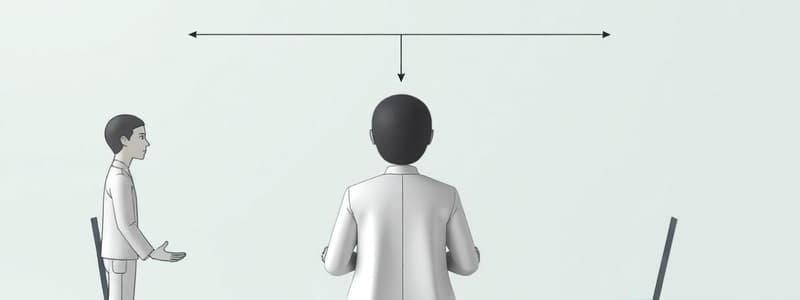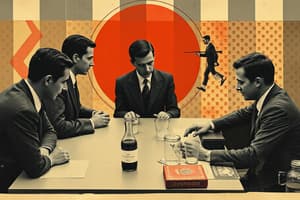Podcast
Questions and Answers
According to Asch's configural model, what type of traits have an outsized impact on overall impression formation?
According to Asch's configural model, what type of traits have an outsized impact on overall impression formation?
- Positivity traits that initially give a better impression.
- Recency traits that are most recently presented.
- Peripheral traits that are easily changed with new information.
- Central traits that disproportionately influence the final impression. (correct)
Which of the following best illustrates the primacy effect in impression formation?
Which of the following best illustrates the primacy effect in impression formation?
- Forming a lasting negative opinion of someone based on a recent argument.
- Remembering the last few items on a shopping list due to their recent occurrence.
- Giving more weight to first impressions, even when later information contradicts them. (correct)
- Ignoring negative information and focusing solely on positive aspects of a person.
Why might negative information have a disproportionate impact on our impressions of others?
Why might negative information have a disproportionate impact on our impressions of others?
- Because negative information is quickly forgotten in the light of positive experiences.
- Because people generally expect the worst from others by default.
- Because negative information is easily ignored in favor of positive traits.
- Because people tend to assume the best of others, negative information stands out. (correct)
What are knowledge structures that organize our understanding of the world?
What are knowledge structures that organize our understanding of the world?
Which type of schema is most relevant when considering how one should act at a specific event, such as attending a lecture?
Which type of schema is most relevant when considering how one should act at a specific event, such as attending a lecture?
What is a 'prototype' in the context of social schemas and categories?
What is a 'prototype' in the context of social schemas and categories?
If someone generalizes that all members of a group share identical characteristics, despite individual differences, what are they exhibiting?
If someone generalizes that all members of a group share identical characteristics, despite individual differences, what are they exhibiting?
What is the primary influence on the change of stereotypes?
What is the primary influence on the change of stereotypes?
What is the accentuation principle?
What is the accentuation principle?
Why are schemas important for navigating the world, despite their potential to cause errors?
Why are schemas important for navigating the world, despite their potential to cause errors?
What is 'priming' in the context of social cognition?
What is 'priming' in the context of social cognition?
What is the 'perseverance effect' in the context of schemas?
What is the 'perseverance effect' in the context of schemas?
According to Rothbart (1981), how do schemas change when faced with inaccuracy?
According to Rothbart (1981), how do schemas change when faced with inaccuracy?
How does the 'self-fulfilling prophecy' affect our schemas?
How does the 'self-fulfilling prophecy' affect our schemas?
What does 'salience' refer to in the context of social encoding?
What does 'salience' refer to in the context of social encoding?
Which of the following makes an item most vivid?
Which of the following makes an item most vivid?
What does social psychology suggest regarding how we store information about others in memory?
What does social psychology suggest regarding how we store information about others in memory?
What is the definition of social cognition?
What is the definition of social cognition?
What did Kurt Lewin contribute to social cognition?
What did Kurt Lewin contribute to social cognition?
What did Solomon Asch contribute to social cognition?
What did Solomon Asch contribute to social cognition?
What is a peripheral trait?
What is a peripheral trait?
If you met a person who seemed nice upon first impression, which of their traits might be remembered more vividly?
If you met a person who seemed nice upon first impression, which of their traits might be remembered more vividly?
In what effect does the order that information is presented affect social cognition and impression formation?
In what effect does the order that information is presented affect social cognition and impression formation?
What is the recency effect?
What is the recency effect?
What causes the recency effect?
What causes the recency effect?
How does physical appearance influence our first impressions of people?
How does physical appearance influence our first impressions of people?
Under schemas, thinking is considered:
Under schemas, thinking is considered:
What can be said of stereotypes?
What can be said of stereotypes?
How are memories organized?
How are memories organized?
What condition causes people to lose the ability to form new memories and view every situation as if they were encountering it for the first time?
What condition causes people to lose the ability to form new memories and view every situation as if they were encountering it for the first time?
How is a memory retrieved?
How is a memory retrieved?
What is Rothbart's Bookkeeping process?
What is Rothbart's Bookkeeping process?
What process says that when expectations influence behavior, that confirms initial expectation?
What process says that when expectations influence behavior, that confirms initial expectation?
What happens with actions when people are salient?
What happens with actions when people are salient?
An intrinsic property of a stimulus on its own that makes it stand out and attract attention is the definition of what?
An intrinsic property of a stimulus on its own that makes it stand out and attract attention is the definition of what?
Why do traits, behaviors, and appearance get stored like a picture in the mind?
Why do traits, behaviors, and appearance get stored like a picture in the mind?
In social inference, if you are to automatcially rely on general schemas or stereotypes in a top down deductive fashion, what are you performing?
In social inference, if you are to automatcially rely on general schemas or stereotypes in a top down deductive fashion, what are you performing?
What heuristic leads you to ignore other relevant information?
What heuristic leads you to ignore other relevant information?
When it is easier to bring information to mind, what is likely to happen?
When it is easier to bring information to mind, what is likely to happen?
In gathering information, what is a small sample?
In gathering information, what is a small sample?
What happens if you under use base-rate information?
What happens if you under use base-rate information?
Flashcards
Social Cognition
Social Cognition
Cognitive processes and structures that influence and are influenced by social behaviour.
Asch's Configural Model
Asch's Configural Model
People form a coherent image of others, even with incongruent information; some pieces weigh more and color overall impression.
Central traits
Central traits
Traits with disproportionate influence on the final impression configuration.
Peripheral traits
Peripheral traits
Signup and view all the flashcards
Primacy Effect
Primacy Effect
Signup and view all the flashcards
Recency Effect
Recency Effect
Signup and view all the flashcards
Positivity and Negativity Bias
Positivity and Negativity Bias
Signup and view all the flashcards
Physical Appearance
Physical Appearance
Signup and view all the flashcards
Automatic Thinking
Automatic Thinking
Signup and view all the flashcards
Schema
Schema
Signup and view all the flashcards
Person Schema
Person Schema
Signup and view all the flashcards
Role Schema
Role Schema
Signup and view all the flashcards
Scripts
Scripts
Signup and view all the flashcards
Self-Schemas
Self-Schemas
Signup and view all the flashcards
Prototype
Prototype
Signup and view all the flashcards
Exemplars
Exemplars
Signup and view all the flashcards
Stereotype
Stereotype
Signup and view all the flashcards
Accentuation Principle
Accentuation Principle
Signup and view all the flashcards
Accessibility
Accessibility
Signup and view all the flashcards
Priming
Priming
Signup and view all the flashcards
Schema Persistence
Schema Persistence
Signup and view all the flashcards
Bookkeeping
Bookkeeping
Signup and view all the flashcards
Conversion
Conversion
Signup and view all the flashcards
Subtyping
Subtyping
Signup and view all the flashcards
Self-Fulfilling Prophecy
Self-Fulfilling Prophecy
Signup and view all the flashcards
Salience
Salience
Signup and view all the flashcards
Vividness
Vividness
Signup and view all the flashcards
Person Memory
Person Memory
Signup and view all the flashcards
Representative Heuristic
Representative Heuristic
Signup and view all the flashcards
Availability Heuristic
Availability Heuristic
Signup and view all the flashcards
Anchoring and Adjustment
Anchoring and Adjustment
Signup and view all the flashcards
Small Sample Bias
Small Sample Bias
Signup and view all the flashcards
Ignoring Base-Rate Information
Ignoring Base-Rate Information
Signup and view all the flashcards
Study Notes
- Social Cognition refers to the cognitive processes and structures influencing and being influenced by social behavior
- Kurt Lewin lived from 1890-1947
Asch's Configural Model
- People form a coherent image of others even with limited or conflicting information.
- Some pieces of information are more influential and color the overall impression.
- Central traits have a disproportionate impact on the configuration of final impressions.
- Peripheral traits have an insignificant influence on the configuration of final impressions.
- Solomon Asch lived from 1907-1996
- Information about central traits impacts others' perceptions more than information about peripheral traits.
- People are more open to making inferences about someone with a central trait, such as morality, compared to a peripheral trait like thriftiness.
- A peripheral trait doesn't imply many other characteristics.
Biases in Forming Impressions
- Primacy effect results from the order of presentation effect, where earlier information has a disproportionate influence on social cognition
- Recency effect results from the order of presentation effect, where later information has a disproportionate influence on social cognition
- In recency effect experiments, subjects given a list of traits recalled items at the end of the list best as these items were learned most recently
- The first few items are recalled better than those in the middle, illustrating the primacy effect.
- Recency effect may happen when too tired or overworked by stimuli
Positivity and Negativity
- People generally assume the best and form positive impressions of others
- Negative information tends to attract attention and may have disproportionate importance
- Negative impressions are harder to change with positive information than positive impressions are with negative information.
Physical Appearance
- People's appearance is often the initial information received and greatly influences first impressions.
Automatic Thinking
- Automatic thinking is non-conscious, unintentional, involuntary, and effortless.
Social Schemas and Categories
- People use automatic thinking with schemas, similar to scientists using hypotheses.
- A schema is a general term for an organized knowledge body representing everything an individual knows
- Schemas can relate to social roles like "what a librarian is like" or specific events like "what usually happens when people eat a meal in a restaurant".
Types of Schemas
- Person Schema includes individualized knowledge structures about specific people.
- An example is "Ayşe is kind and intelligent and likes mountain climbing"
- Role Schemas are knowledge structures about role occupants such as doctors
- An example is "Doctors are often complete strangers that are allowed to ask personal questions and get you to undress".
- Scripts are schemas about events, such as attending a lecture or eating at a restaurant.
- Self-Schemas include schemas about themselves and are part of one's self-concept
Prototypes and Exemplars
- Schematic knowledge requires categorizing people, events, or situations into schemas.
- A prototype is a cognitive representation of the typical or ideal defining features of a category
- Exemplars are specific instances of a category member
- When evaluating a partner, people compare the person with a prototype (ideal) and old flames (exemplars).
Categories
- The relationship between categories is hierarchical with less inclusive categories nested beneath more inclusive categories.
- Intermediate-level categories are relied on more than vehicle
Stereotypes
-
Stereotypes generalize about a group and assign identical characteristics to virtually everyone in the group, regardless of actual variation.
-
Beliefs about a group's typical characteristics
-
Stereotypes are widely shared generalizations about members of a social group and are slow to change.
-
People readily characterize human groups with crude common attributes.
-
Stereotypes change due to social, political, or economic shifts and are acquired early in life.
-
Stereotypes become pronounced and hostile during social tensions and are difficult to modify.
Categorization
- Categorization may be responsible for stereotyping and can accentuate perceived similarities within and differences between groups (Accentuation Principle).
- Memory constructions tend to be consistent with schemas
- In marriage proposal conditions subjects recall details, regardless of truth
- Conditions in rape conditions create similar misremembered circumstances
The Function of Schemas
- Schemas are important for organizing and making sense of the world.
- Korsokov's Syndrome is when a person loses the ability to form new memories and they approach every situation as if they were encountering it for the first time.
- Continuity is required to relate to new experiences for past schemas
- Sergei Korsokov lived from 1853-1900
Accessibility and Priming
-
Accessibility is the extent to which schemas and concepts are at the forefront of people's minds and are likely to be used when making judgments
-
If there's a history of alcoholism in family traits, describing an alcoholic are likely to be accessible.
-
Priming is the process by which recent experiences increase the accessibility of a schema, trait, or concept.
-
Memories are stored in a web of associations, activating one strand is required to retrieve a memory
-
Reading "One Flew Over the Cuckoo's Nest" might lead someone to believe a strangely behaving man on the bus is mentally ill
-
Priming might occur even by flashing words too quickly to recognize.
-
Schemas can persist even after being discredited.
-
Ross, Lepper& Hubbard did a 1975 study where subjects are given suicide notes, both real and fake to which they have to determine which are real.
-
Subjects were told if they were right or wrong.
-
At the end, researchers told the subjects that the test was aimed at understanding their physiological responses
-
Subjects' guesses were close to their previous feedback
-
Perseverance effect
-
Gross inaccuracy can lead to schema change.
-
Rothbart suggested three schema change processes in 1981:
-
Bookkeeping includes a slow process of gradual change using new evidence
-
Conversion includes disconfirming information gradually accrues until a sudden shift occurs.
-
Subtyping includes schemas that change their configuration, using subcategories.
Self Fulfilling Prophecy
- The Self-Fulfilling Prophecy occurs when expectations influence behavior to align with those expectations.
- Rosenthal and Jacobson conducted a study in 1968 based on this premise
- Teachers were told which students had scored so well, when in reality students were randomly chosen
- Two years later, a retest of the students led to significantly higher IQs, proving that the prophecy came true
- Teachers gave students a warmer climate, personal attention, and support.
- Teachers also allowed students to use more material and gave the students more opportunity in the class.
Social Encoding
- Social encoding depends on what describes attention
- Salience captures attention. Salience refers to a stimulus standing out to attract attention:
- People can be salient if they're unique, uncommon, original (single man, pregnant woman) or bright
- Behaving in ways not expected for who they are to begin with
- Important for goals, dominating visual field or told to pay attention
- Salient people get attract attention, are influential and are seen as personally responsible and not by situation
Vividness
- Vividness means that a stimulus has to stand out and attract attention
- Vivid stimuli are emotionally interesting, concrete and image provoking, and nearby.
Person Memory
- Social behavior depends on how we store information about people.
- Social Psychology primarily uses associative networks or prepositional models of memory.
- General idea is statements (propositions) are how we store them
- Prepositions consists of ideas/nodes being linked by ideas
- Links are associative, meaning nodes are in coordination with each other. Links strengthens more from cognitive rehearsal.
Organization of Person Memory
- Remembrance of individuals involves combining information of traits, behaviors, and appearances, creating clusters under attributes or groups.
Social Inference
- There are two different ways to process social information: relying automatically on general schemas or stereotypes (top-down, deductive) and relying deliberately on specific instances (bottom-up, inductive).
Representative Heuristic
- Representative Heuristic is the strategy to judge likelihood through well representative/ comparable prototypes and may lead to ignoring information
- Comparing to the mental representation of certain category.
- Likelihood of person being with group increases if similiar to existing group
Availability Heuristic
- The easier it is to process the impact information, the greater the effect.
- If events come to mind, we assume the event is commonplace.
Anchoring and Adjustment
- Anchoring and Adjustment has inferences that are tied to initial anchors
- People may give sentences according to this starting figure
- Biases may include the use of:
- Small sample: problematic inferences based on minimal data
- Ignoring/under using base-rate information: factual statistical about events
Studying That Suits You
Use AI to generate personalized quizzes and flashcards to suit your learning preferences.




